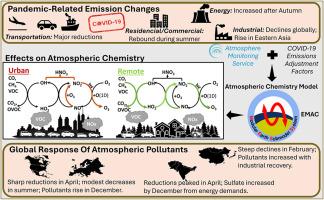揭示二次大气污染物对2019冠状病毒病大流行期间实施的减排的全球反应
IF 3.4
Q2 ENVIRONMENTAL SCIENCES
引用次数: 0
摘要
本研究采用全球化学-气候模型EMAC,结合排放调整因子(validate),评估2020年新冠肺炎封港对全球二次大气污染物的影响。与以往仅限于短期或特定区域的研究不同,这项工作捕捉到了排放和污染物形成的季节、空间和部门变化。它检查了主要污染物(如氮氧化物、二氧化硫)和二次污染物,如臭氧和PM2.5成分。模拟结果显示,在封城期间,欧洲和东亚的氮氧化物峰值分别下降了31%和25%。南亚的二氧化硫下降了20%,而东亚由于工业活动增加,在封城后出现了14%的反弹。臭氧响应因区域而异,由于滴定减少,东亚城市地区增加了4%,而南亚则减少了1.4%。气溶胶浓度也有类似的区域趋势。硫酸盐在南亚下降了17%,而硝酸盐和铵在欧洲分别下降了27%和33%。全球初级有机气溶胶减少了4%,南亚减少了8%。二次有机气溶胶下降了4%,拉丁美洲和加勒比地区下降幅度最大(8%)。总体而言,陆地PM2.5下降了2%,其中欧洲区域降幅最大(6%)。这些结果突出了与大流行有关的排放变化的重大但区域差异的影响。然而,即使是短期大幅减排对PM2.5水平的影响也有限,这突出表明需要持续大规模减排,以达到世卫组织空气质量指南的要求。本文章由计算机程序翻译,如有差异,请以英文原文为准。

Unraveling the global response of secondary atmospheric pollutants to emission reductions imposed during the COVID-19 pandemic
This study employs the global chemistry–climate model EMAC, combined with emission adjustment factors (CONFORM), to evaluate the global impacts of the 2020 COVID-19 lockdowns on secondary air pollutants. Unlike earlier studies limited to short periods or specific regions, this work captures seasonal, spatial, and sectoral variability in emissions and pollutant formation. It examines both primary pollutants (e.g., NOx, SO2) and secondary pollutants such as ozone and PM2.5 components. Significant NOx reductions were simulated, with peak decreases of 31 % in Europe and 25 % in Eastern Asia during lockdowns. SO2 dropped by up to 20 % in Southern Asia, while Eastern Asia saw a 14 % post-lockdown rebound due to increased industrial activity. Ozone responses varied regionally, with increases of up to 4 % in urban areas in Eastern Asia due to reduced titration, while Southern Asia saw decreases up to 1.4 %. Aerosol concentrations followed similar regional trends. Sulfate declined by 17 % in Southern Asia while nitrate and ammonium dropped by 27 % and 33 % in Europe, respectively. Global primary organic aerosol decreased by 4 %, with South Asia showing an 8 % reduction. Secondary organic aerosol fell by 4 %, with the largest drop (8 %) in Latin America and the Caribbean. Overall, PM2.5 over land declined by 2 %, with Europe showing the largest regional decrease (6 %). These results highlight the substantial but regionally varied effects of pandemic-related emission changes. However, even substantial short-term reductions had limited impact on PM2.5 levels, underscoring the need for sustained, large-scale emission cuts to meet WHO air quality guidelines.
求助全文
通过发布文献求助,成功后即可免费获取论文全文。
去求助
来源期刊

Atmospheric Environment: X
Environmental Science-Environmental Science (all)
CiteScore
8.00
自引率
0.00%
发文量
47
审稿时长
12 weeks
 求助内容:
求助内容: 应助结果提醒方式:
应助结果提醒方式:


